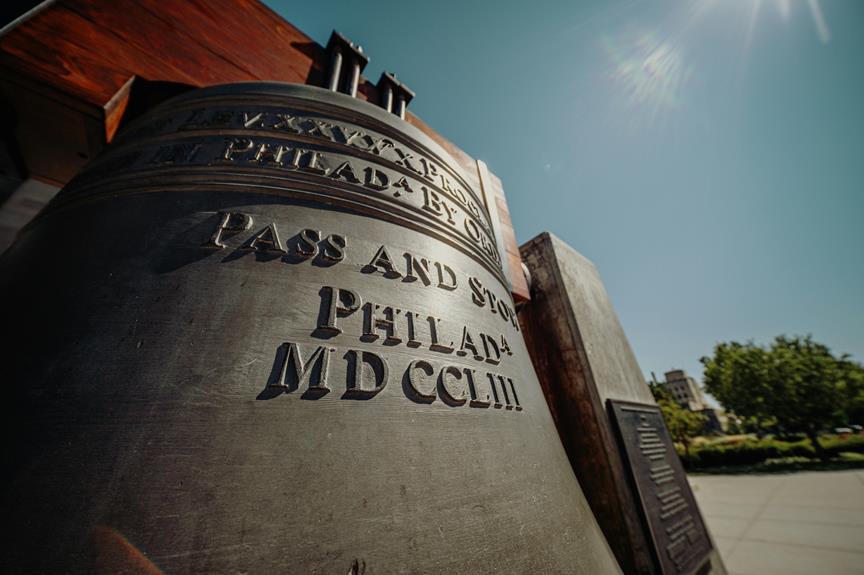The War Remnants Museum in Ho Chi Minh City stands as a solemn testament to the enduring impact of the Vietnam War. Through meticulously curated exhibits and poignant displays, the museum offers a stark portrayal of the conflict's brutal realities. Visitors are confronted with powerful images and artifacts that vividly capture the human cost of war, sparking contemplation and reflection. As a repository of history and a call for peace, the museum invites patrons to confront uncomfortable truths and engage in a dialogue that transcends borders and generations.
Key Takeaways
- Showcases detailed overview of the Vietnam War
- Preserves historical artifacts and documents
- Exhibits outdoor display of military equipment
- Highlights the impact of Agent Orange
- Features powerful war photography exhibition
Museum Overview
Located in Ho Chi Minh City, Vietnam, the War Remnants Museum offers visitors a detailed overview of the Vietnam War and its impact on the country. The museum provides a thorough historical context for understanding the complexities and consequences of one of the most significant conflicts in modern history.
Upon entering the museum, visitors are greeted with displays detailing the events leading up to the Vietnam War, including the struggle for independence from French colonial rule and the subsequent involvement of the United States. The exhibits offer an inclusive educational experience, showcasing photographs, artifacts, and documents that shed light on the political, social, and cultural aspects of the war.
One of the highlights of the museum is the outdoor display of military equipment, including tanks, helicopters, and planes used during the conflict. These artifacts provide a tangible connection to the past and offer visitors a glimpse into the realities of war.
Historical Significance
The historical significance of the War Remnants Museum in Vietnam lies in its meticulous preservation and presentation of the multifaceted impact of the Vietnam War on the nation and its people. Through its exhibits and artifacts, the museum vividly portrays the harsh realities of the war, showcasing the devastating impact it had on both the Vietnamese people and the soldiers involved. By providing a thorough view of the conflict, the museum serves as a powerful reminder of the toll that war takes on all those involved, fostering a deeper understanding of the complexities and consequences of armed conflict.
Moreover, the War Remnants Museum plays an important role in promoting reconciliation by offering a platform for reflection and dialogue. By confronting the past and acknowledging the suffering experienced by all sides, the museum contributes to the healing process and encourages visitors to contemplate the importance of peace and understanding. Through its exhibitions, the museum encourages visitors to learn from history and work towards a future free from conflict and division.
In essence, the War Remnants Museum stands as a poignant symbol of remembrance and reflection, highlighting the enduring impact of the Vietnam War while promoting the values of reconciliation and peace.
Permanent Exhibits
Within the War Remnants Museum, the collection of permanent exhibits meticulously illustrates the various aspects of the Vietnam War's impact on individuals and society. These exhibits include a wide array of historical artifacts that vividly depict the harsh realities of wartime atrocities experienced during the conflict.
One of the most striking exhibits is the display showcasing photographs and personal accounts of individuals affected by the war. These powerful images and narratives provide visitors with a poignant glimpse into the human cost of the Vietnam War, highlighting the suffering endured by both civilians and soldiers.
In addition to personal stories, the permanent exhibits also feature artifacts such as military equipment, weapons, and uniforms used during the war. These items offer insight into the technological aspects of the conflict and help visitors understand the strategies employed by both sides.
Furthermore, the museum houses exhibits dedicated to documenting specific wartime atrocities, such as the My Lai Massacre. These sections provide detailed historical accounts and evidence of the tragic events that unfolded during the war, shedding light on the darker chapters of Vietnam's history.
Agent Orange Display
Amidst the somber halls of the War Remnants Museum, the Agent Orange Display vividly encapsulates the enduring legacy of chemical warfare during the Vietnam War. This exhibit serves as a poignant reminder of the long-lasting impact of toxic herbicides like Agent Orange, which were heavily sprayed by the U.S. military during the conflict. The display explores the devastating health effects on both Vietnamese civilians and military personnel, as well as the profound environmental damage inflicted upon the Vietnamese landscape.
| Agent Orange Display | ||
|---|---|---|
| Health Effects | Environmental Damage | Legacy |
| – Cancer | – Deforestation | – Ongoing health issues |
| – Birth defects | – Soil contamination | – Ecological disruption |
| – Neurological disorders | – Water pollution | – Advocacy for victims |
The exhibit meticulously showcases the correlation between Agent Orange exposure and the prevalence of various diseases among the Vietnamese population. Moreover, it educates visitors on the broader repercussions of chemical warfare, emphasizing the critical need for accountability and redress for those affected. By shedding light on the dark chapters of history, the Agent Orange Display at the War Remnants Museum stands as a stark warning against the devastating consequences of war tactics that prioritize military objectives over human and environmental well-being.
War Photography Section
Highlighting the significance of visual documentation, the War Remnants Museum's War Photography Section offers a compelling insight into the impact of photography on shaping historical narratives of conflict. This section houses a collection of powerful images captured during the Vietnam War, showcasing the raw realities of battle, suffering, and resilience. Through these photographs, visitors are confronted with the ethical considerations surrounding war photography, prompting contemplation on the boundaries of representation in times of conflict.
The War Photography Section explores the ethical dilemmas faced by photographers in war zones, examining questions of consent, exploitation, and the potential effects of graphic imagery on viewers. It invites reflection on the responsibilities of photographers in documenting wartime events while respecting the dignity and privacy of those affected. Additionally, the section prompts discussions on how these images contribute to shaping public perceptions and historical narratives of war, emphasizing the pivotal role of photography in preserving collective memory.
Outdoor Military Vehicles
The display of outdoor military vehicles at the War Remnants Museum provides visitors with a tangible connection to the historical context of warfare in Vietnam. Among the exhibits are vintage tanks that were once utilized during the Vietnam War. These tanks, such as the iconic T-54 Soviet tank, serve as powerful reminders of the intense armored warfare that took place in the region.
In addition to the vintage tanks, the outdoor display features several military helicopters that were pivotal during the conflict. Visitors can observe helicopters like the Bell UH-1 Iroquois, commonly known as the 'Huey,' which played a significant role in various military operations during the war. The sight of these helicopters sparks contemplation about the logistical challenges and aerial strategies employed during the conflict.
Each military vehicle on display is accompanied by informative plaques detailing its history and significance, offering visitors a deeper understanding of the roles these machines played in shaping the outcome of the war. The well-preserved condition of these vehicles allows for a vivid portrayal of the harsh realities of armed conflict and the technological advancements that characterized the Vietnam War era.
Impact on Civilians
What were the profound consequences of the Vietnam War on civilians living in the region?
The Vietnam War had a devastating impact on civilians, leaving behind a trail of destruction and psychological trauma that would linger for generations. From the civilian perspective, the war brought unimaginable suffering and loss, with millions of innocent men, women, and children caught in the crossfire of a conflict that tore apart the fabric of Vietnamese society.
Psychological trauma was widespread among civilians who experienced the horrors of war firsthand. The constant threat of violence, displacement from their homes, and the loss of loved ones left deep emotional scars that would shape the post-war landscape. Families were torn apart, communities were decimated, and the psychological toll of living through such turmoil was immeasurable.
From the civilian perspective, the Vietnam War was not just a political or military conflict; it was a human tragedy of immense proportions. The War Remnants Museum in Vietnam serves as a stark reminder of the impact on civilians, preserving the stories of those who endured unspeakable hardships during this dark chapter in history. By highlighting the civilian perspective, visitors are confronted with the true cost of war and the importance of working towards peace and freedom in a world scarred by conflict.
Post-War Healing
Post-war healing initiatives in Vietnam have played a significant role in addressing the deep-seated wounds inflicted by the protracted conflict. The healing process following such a traumatic period has been pivotal in helping individuals and communities cope with the emotional scars left behind. Here are five key aspects of post-war healing in Vietnam:
- Reconciliation Efforts: Initiatives promoting reconciliation between former enemies have been instrumental in fostering understanding and forgiveness, essential for moving forward from the conflict's lingering animosities.
- Mental Health Support: Providing accessible mental health services has been essential in assisting individuals in dealing with the psychological toll of war, aiding in their healing journey.
- Community Reintegration Programs: Programs aimed at reintegrating veterans and affected communities back into society have been crucial in rebuilding social bonds and support networks.
- Educational Campaigns: Educational initiatives focusing on the war's history and its impacts have helped raise awareness and promote empathy, contributing to the healing process on a societal level.
- Memorialization and Commemoration: Memorials and commemorative events serve as important reminders of the past, honoring those who suffered and providing spaces for collective healing and reflection.
Through these various avenues, Vietnam has made significant strides in addressing the aftermath of war and supporting individuals in their healing processes, aiming to create a more harmonious and reconciled society.
Visitor Information
Visitor access to the War Remnants Museum in Vietnam is facilitated through a structured ticketing system that accommodates both individual and group visits. The museum welcomes a diverse range of visitor demographics, including local residents, international tourists, students, historians, and war veterans. This broad spectrum of visitors contributes to the museum's mission of promoting understanding and healing in the aftermath of the Vietnam War.
Educational programs play an essential role in enhancing the visitor experience at the War Remnants Museum. The museum offers guided tours, lectures, and interactive exhibits that provide in-depth historical context and encourage reflection on the impact of war. These programs cater to visitors of all ages and backgrounds, fostering a sense of empathy and awareness among participants.
For individual visitors, the museum provides informational materials, audio guides, and multimedia presentations that offer a self-guided exploration of the exhibits. Group visits, including school outings and organized tours, can benefit from specialized educational programs tailored to specific interests and learning objectives. By engaging visitors through informative and thought-provoking experiences, the War Remnants Museum serves as a crucial platform for education, reconciliation, and dialogue surrounding the complexities of war and its enduring consequences.
Museum Hours and Admission
The operational schedule of the War Remnants Museum in Vietnam, coupled with its admission policies, are structured to accommodate visitors with varying schedules and preferences. The museum operates from 7:30 am to 6:00 pm daily, offering ample time for visitors to explore the exhibits at their own pace.
When planning a visit to the museum, it is essential to take into account the following key points:
- Ticket Prices: The War Remnants Museum offers affordable admission prices, making it accessible to a wide range of visitors. The entrance fee for adults is 40,000 VND, which is approximately $1.75, and for children under 16 years old, the ticket price is 10,000 VND, around $0.44. Students with a valid ID can enjoy a discounted rate of 5,000 VND, equivalent to $0.22.
- Tour Availability: Guided tours are available for those who wish to explore further into the historical significance of the museum's artifacts. These tours are typically led by knowledgeable guides who provide valuable insights into the exhibits on display. Visitors can inquire about tour availability at the museum's entrance or book in advance for a more structured experience.
- Special Events: The museum occasionally hosts special events such as talks, film screenings, and exhibitions related to the Vietnam War. These events offer visitors a unique opportunity to engage with the history presented in a more interactive setting.
- Group Visits: Groups planning to visit the museum can benefit from discounted group rates. Organized tours or school groups can inquire about group packages to make the most of their visit while saving on admission costs.
- Accessibility: The museum is wheelchair accessible, ensuring that all visitors, regardless of mobility challenges, can navigate the exhibits comfortably. Additionally, there are facilities in place to accommodate visitors with special needs, promoting an inclusive environment for all.
Frequently Asked Questions
Are There Any Interactive Exhibits for Visitors to Engage With?
Interactive activities play an essential role in engaging visitors and enhancing their overall experience. Such activities can include multimedia presentations, virtual reality simulations, hands-on exhibits, and educational workshops.
How Does the Museum Preserve and Maintain Its Artifacts?
Preservation methods and conservation efforts play pivotal roles in safeguarding the integrity of historical artifacts. Through meticulous attention to detail and strategic conservation practices, museums can guarantee the longevity and authenticity of their collections.
By employing innovative techniques and adhering to ethical standards, institutions can uphold the significance of artifacts for future generations.
The careful balance between preservation and accessibility is key in maintaining the cultural heritage encapsulated within these precious objects.
Can Visitors Donate Items Related to the Vietnam War?
Visitors to museums often inquire about donating relevant items, recognizing their historical significance and cultural impact. Donor contributions play an essential role in enriching museum collections, aiding preservation efforts, and offering diverse perspectives.
Institutions typically have guidelines for accepting donations, ensuring items align with their mission and collection policies. By actively engaging with potential donors and evaluating proposed artifacts, museums can continue to expand their holdings and provide valuable insights into our shared history.
Are There Any Special Events or Programs Held at the Museum?
The museum hosts a variety of engaging events throughout the year, ranging from special performances to insightful lectures.
Additionally, visitors can participate in educational workshops and guided tours that provide in-depth knowledge about the historical significance of the exhibits.
These programs offer a unique opportunity for individuals to deepen their understanding of the subject matter and engage with the museum's collection in a more interactive and enriching manner.
Are There Any Restrictions on Photography or Filming Inside the Museum?
Photography restrictions and filming limitations are common practices in museums worldwide to maintain the sanctity of exhibits and protect intellectual property. These guidelines often aim to guarantee the safety of artifacts and the privacy of visitors. Such regulations promote a respectful environment for all patrons and help uphold the integrity of the museum's collections.
Adhering to these restrictions fosters a positive experience for visitors while supporting the museum's mission of education and preservation.
Conclusion
In the heart of Ho Chi Minh City, the War Remnants Museum stands as a solemn tribute to the brutal realities of the Vietnam War. Through its exhibits and displays, the museum portrays the devastating impact of the conflict on both soldiers and civilians.
It serves as a stark reminder of the horrors of war and the importance of promoting peace and understanding in our world today. Visit the museum to witness history and reflect on the consequences of violence.


